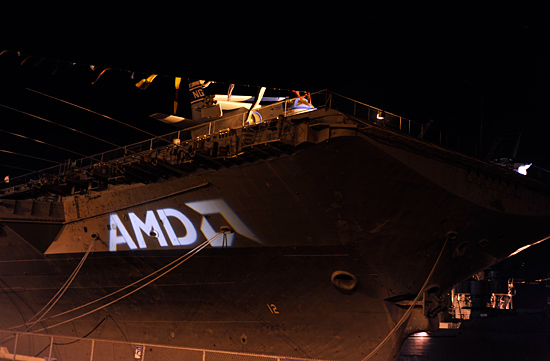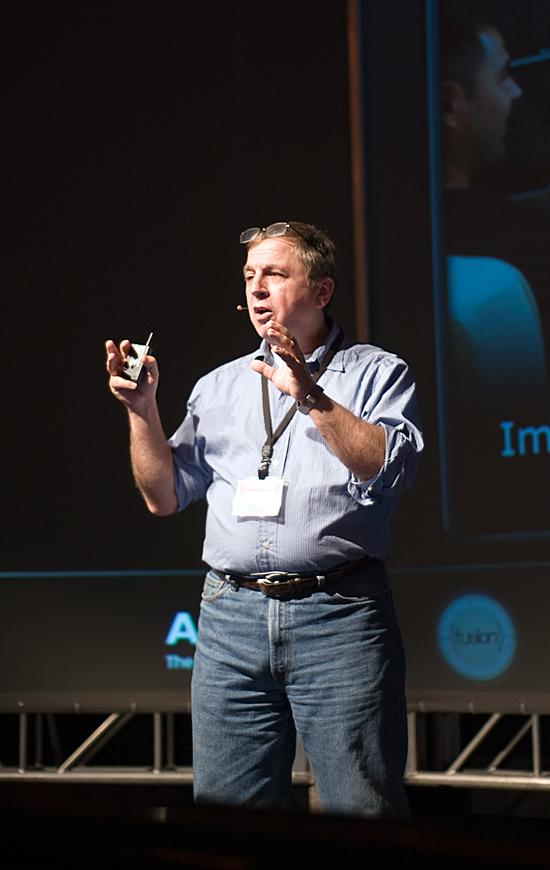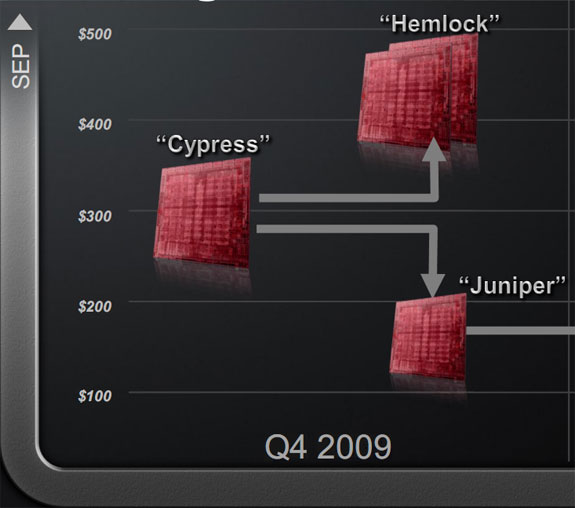The RV870 Story: AMD Showing up to the Fight
by Anand Lal Shimpi on February 14, 2010 12:00 AM EST- Posted in
- GPUs
The Call
My love/hate relationship with AMD PR continued last year. But lately, it’s been far less hate. Let’s rewind back to the Summer of 2009. I’d been waiting for AMD to call for weeks.
We all knew that the RV870 was going to launch sometime before the end of the year, and we’re normally briefed on new GPUs around a month or so before we get hardware. The rumors said that the launch had been pushed back, but just like clockwork I got a call in June or July of last year. It was my old friend, Chris Hook of AMD PR.

This time he wanted me to come to a press event on a carrier off the coast of California. Sigh.
It’s not that I have anything against carriers. It’s just that all I cared about at that time was the long awaited successor to the RV770. The RV770 was the GPU that unequivocally restored my faith in ATI graphics, an impact shared by others last June. But that’s not how the game is played I’m afraid. AMD promises its management and its partners that they can fill a room (or carrier) up with important press. We get promised access to engineers, useful information and free drinks.

The USS Hornet. GPUs are in there.
I’m not easily swayed by free drinks, but Chris Hook knows me well enough by now to know what I’d appreciate even more.
The Dinner - September 2009
I had to leave dinner earlier than I wanted to. ASUS’ Chairman Jonney Shih was in town and only had one opportunity to meet me before I left Oakland. Whenever either of us happens to be in the same town, we always make our best effort to meet - and I wasn’t going to let him down. In the same vein that Steve Jobs is successful because he is a product guy at heart, running a company best known for its products. Jonney Shih is an engineer at heart, and he runs a company who has always been known for their excellence in engineering. This wasn’t just another meeting with an executive, this was a meeting with someone who has a passion for the same things I do. His focus isn’t on making money, it’s on engineering. It’s a rare treat.
My ride was waiting outside. I closed the lid on my laptop, making sure to save the 13 pages of notes I just took while at dinner. And I shook this man’s hand:

Before I left he asked me to do one thing. He said “Try not to make the story about me. There are tons of hardworking engineers that really made this chip happen”. Like Jonney, Carrell Killebrew has his own combination of traits that make him completely unique in this industry. All of the greats are like that. They’ve all got their own history that brought them to the companies that they work for today, and they have their own sets of personality traits that when combined make them so unique. For Carrell Killebrew it's a mixture of intelligence, pragmatism, passion and humility that's very rare to see. He's also a genuinely good guy. One of his tenets is that you should always expect the best from others. If you expect any less than the best, that’s all you’ll ever get from them. It’s a positive take on people, one that surprisingly enough only burned Carrell once. Perhaps he’s more fortunate than most.
Mr. Killebrew didn’t make the RV870, but he was beyond instrumental in making sure it was a success. What follows is a small portion of the story of the RV870, the GPU behind the Radeon HD 5800 series. I call it a small portion of the story because despite this article using more than eight thousand words to tell it, the actual story took place over years and in the minds and work of hundreds of engineers. This GPU, like all others (even Fermi) is the lifework of some of the best engineers in the industry. They are the heroes of our industry, and I hope I can do their story justice.
As is usually the case with these GPU backstories, to understand why things unfolded the way they did we have to look back a few years. Introducing a brand new GPU can take 2 - 4 years from start to finish. Thus to understand the origins of the Radeon HD 5800 series (RV870) we have to look back to 2005.
Sidebar on Naming
AMD PR really doesn’t like it when I use the name RV870. With this last generation of GPUs, AMD wanted to move away from its traditional naming. According to AMD, there is no GPU called the RV870, despite the fact that Carrell Killebrew, Eric Demers and numerous others referred to it as such over the past couple of years. As with most drastic changes, it usually takes a while for these things to sink in. I’ve also heard reference to an RV870 jar - think of it as a swear jar but for each time someone calls Cypress an RV870.

Why the change? Well, giving each member of a GPU family a name helps confuse the competition. It’s easy to know that RV870 is the successor to the RV770. It’s harder to tell exactly what a Cypress is.
AMD PR would rather me refer to RV870 and the subject of today’s story as Cypress. The chart below shows AMD’s full listing of codenames for the 40nm DX11 GPU lineup:
| GPU | Codename |
| ATI Radeon HD 5900 Series | Hemlock |
| ATI Radeon HD 5800 Series | Cypress |
| ATI Radeon HD 5700 Series | Juniper |
| ATI Radeon HD 5600/5500 Series | Redwood |
| ATI Radeon HD 5400 Series | Cedar |
Given that we still haven’t purged the RVxxx naming from our vocabulary, I’m going to stick with RV870 for this story. But for those of you who have embraced the new nomenclature - RV870 = Cypress and at points I will use the two names interchangeably. The entire chip stack is called Evergreen. The replacement stack is called the Northern Islands.










132 Comments
View All Comments
Dudler - Sunday, February 14, 2010 - link
Your reasoning is wrong. The 57xx is a performance segment down from the 48xx segment. By your reasoning the 5450 should be quicker than the last gen 4870X2. The 5870 should be compared to the 4870, the 5850 to 4850 and so on.Regarding price, the article sure covers it, the 40nm process was more expensive than TSMC told Amd, and the yield problems factored in too. Can't blame Amd for that can we?
And finally, don't count out that Fermi is absent to the party. Amd can charge higher prices when there is no competition. At the moment, the 5-series has a more or less monopoly in the market. Considering this, I find their prices quite fair. Don't forget nVidia launched their Gtx280 at $637....
JimmiG - Friday, February 19, 2010 - link
"Your reasoning is wrong. The 57xx is a performance segment down from the 48xx segment. "Well I compared the cards across generations based on price both at launch and how the price developed over time. The 5850 and 4850 are not in the same price segment of their respective generation. The 4850 launched at $199, the 5850 at $259 but quickly climbed to $299.
The 5770 launched at $159 and is now at $169, which is about the same as a 1GB 4870, which will perform better in DX9 and DX10. Model numbers are arbitrary and at the very best only useful for comparing cards within the same generation.
The 5k-series provide a lot of things, but certainly not value. This is the generation to skip unless you badly want to be the first to get DX11 or you're running a really old GPU.
just4U - Tuesday, February 16, 2010 - link
and they are still selling the 275,285 etc for a hefty chunk of change. I've often considered purchasing one but the price has never been right and mail in rebates are a "PASS" or "NO THANKS" for many of us rather then a incentive.I haven't seen the mail-ins for AMD products much I hope their reading this and shy away from that sort of sales format. To many of us get the shaft and never recieve our rebates anyway.
BelardA - Monday, February 15, 2010 - link
Also remind people... the current GTX 285 is about $400 and usually slower than the $300 5850. So ATI is NOT riping off people with their new DX11 products. And looking at the die-size drawings, the RV870 is a bit smaller than the GT200... and we all now that FERMI is going to be another HUGE chip.The only disappointment is that the 5750 & 5770 are not faster than the 4850/70 which used to cost about $100~120 when inventory was good. Considering that the 5700 series GPUs are smaller... Hell, even the 4770 is faster than the 5670 and costs less. Hopefully this is just the cost of production.
But I think once the 5670 is down to $80~90 and the 5700s are $100~125 - they will be more popular.
coldpower27 - Monday, February 15, 2010 - link
nVidia made a conscious decision, not to fight the 5800 Series, with the GTX 200 in terms of a price war. Hence why their price remain poor value. They won't win using a large Gt200b die vs the 5800 smaller die.Another note to keep in mind is that the 5700 Series, also have the detriment of being higher in price due to ATi moving the pricing scale backup a bit with the 5800 Series.
I guess a card that draws much less power then the 4800's, and is close to the performance of those cards is a decent win, just not completely amazing.
MonkeyPaw - Sunday, February 14, 2010 - link
Actually, the 4770 series was meant to be a suitable performance replacement for the 3870. By that scheme, the 5770 should have been comperable to the 4870. I think we just hit some diminishing returns from the 128bit GDDR5 bus.nafhan - Sunday, February 14, 2010 - link
It's the shaders not the buswidth. Bandwidth is bandwidth however you accomplish it. The rv8xx shaders are slightly less powerful on one to one basis than the rv7xx shaders are.LtGoonRush - Sunday, February 14, 2010 - link
The point is that an R5770 has 128-bit GDDR5, compared to an R4870's 256-bit GDDR5. Memory clock speeds can't scale to make up the difference from cutting the memory bus in half, so overall the card is slower, even though it has higher compute performance on the GPU. The GPU just isn't getting data from the memory fast enough.Targon - Monday, February 15, 2010 - link
But you still have the issue of the 4870 being the high end from its generation, and trying to compare it to a mid-range card in the current generation. It generally takes more than one generation before the mid range of the new generation is able to beat the high end cards from a previous generation in terms of overall performance.At this point, I think the 5830 is what competes with the 4870, or is it the 4890? In either case, it will take until the 6000 or 7000 series before we see a $100 card able to beat a 4890.
coldpower27 - Monday, February 15, 2010 - link
Yeah we haven't seen ATi/nVidia achieved the current gen mainstream faster then the last gen high end. Bandwidth issues are finally becoming apparent.6600 GT > 5950 Ultra.
7600 GT > 6800 Ultra.
But the 8600 GTS, was only marginally faster then the 7600 GT and nowhere near 7900 GTX, it took the 8800 GTS 640 to beat the 7900 GTX completely, and the 800 GTS 320 beat it, in the large majority of scenarios, due to frame buffer limitation.
The 4770 slots somewhere between the 4830/4850. However, that card was way later then most of the 4000 series. Making it a decent bit faster then the 3870, which made more sense since the jump from 3870 to 4870 was huge, sometimes nearly even 2.5x could be seen nearly, given the right conditions.
4670 was the mainstream variant and it was, most of the performance of the 3800 Series, it doesn't beat it though, more like trades blows or is slower in general.